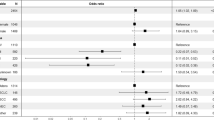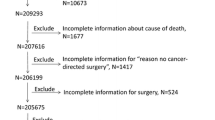Abstract
Background
This study aimed to analyze cause-specific mortality in lung cancer patients over 80 years old undergoing surgery.
Methods
This retrospective, multi-institutional analysis included patients aged ≥ 80 years who underwent radical surgery for primary lung cancer from January 1998 to December 2015. Preoperative clinical data, surgical results, survival, and cause of death were evaluated. Competing risk analysis for cause-specific mortality was performed.
Results
Of the 337 patients (median age 82 years) enrolled and analyzed, 68.1% were male. There were 52 and 44 cancer-specific and non-cancer-specific deaths, respectively. On competing risk regression analysis, non-cancer-specific deaths were significantly associated with male sex (hazard ratio [HR]: 3.06, 95% confidence interval [CI]: 1.02–9.12, p = 0.046), coronary artery disease (HR: 2.49, 95% CI: 2.49 [1.14–5.47], p = 0.02), interstitial pneumonia (HR: 3.58, 95% CI: 1.73–7.40, p < 0.001), and pathological stage III (HR: 3.83, 95% CI: 1.44–10.13, p = 0.007). In contrast, cancer-specific deaths were significantly associated with limited resection (HR: 1.99, 95% CI: 1.02–3.89, p = 0.04) and pathological stage III (HR: 3.13, 95% CI: 1.44–6.80, p = 0.004). The 5-year cumulative incidences of lung cancer-specific and non-cancer-specific deaths were 18.0% and 15.9%, respectively.
Conclusions
Prognostic factors for non-cancer-specific death were different from those of cancer-specific death, except for pathological stage. Each prognostic factor should be considered when deciding surgical indication and procedure and monitoring for pulmonary events during outpatient follow-up.




Similar content being viewed by others
References
Ministry of Health, Labour and Welfare. Vital Statistics Japan (2018). http://www.mhlw.go.jp/toukei/list/dl/81-1a2.pdf. Published 28 March 2018, Accessed 22 May 2018
Masuda M, Okumura M, Doki Y (2016) Committee for Scientific Affairs, The Japanese Association for Thoracic Surgery. Gen Thorac Cardiovasc Surg 64:665–697
Dominguez-Ventura A, Allen MS, Cassivi SD et al (2006) Lung cancer in octogenarians: factors affecting morbidity and mortality after pulmonary resection. Ann Thorac Surg 82:1175–1179
Dominguez-Ventura A, Cassivi SD, Allen MS et al (2007) Lung cancer in octogenarians: factors affecting long-term survival following resection. Eur J Cardiothorac Surg 32:370–374
Okami J, Higashiyama M, Asamura H et al (2009) Pulmonary resection in patients aged 80 years or over with clinical stage I non-small cell lung cancer: prognostic factors for overall survival and risk factors for postoperative complications. J Thorac Oncol 4:1247–1253
Blanchard EM, Arnaoutakis K, Hesketh PJ (2010) Lung cancer in octogenarians. J Thorac Oncol 5:909–916
Fanucchi O, Ambrogi MC, Dini P et al (2011) Surgical treatment of non-small cell lung cancer in octogenarians. Interact CardioVasc Thorac Surg 12:749–753
Hino H, Murakawa T, Ichinose J et al (2015) Results of lung cancer surgery for octogenarians. Ann Thorac Cardiovasc Surg 21:209–216
Saji H, Ueno T, Nakamura H et al (2018) A proposal for a comprehensive risk scoring system for predicting postoperative complications in octogenarian patients with medically operable lung cancer: JACS1303. Eur J Cardiothorac Surg 53:835–841
Hino H, Karasaki T, Yoshida Y, Fukami T, Sano A, Tanaka M, Furuhata Y, Ichinose J, Kawashima M, Nakajima J (2018) Risk factors for postoperative complications and long-term survival in lung cancer patients older than 80 years. Eur J Cardiothorac Surg 53:980–986
Eguchi T, Bains S, Lee MC et al (2017) Impact of increasing age on cause-specific mortality and morbidity in patients with I non-small-cell lung cancer: a competing risks analysis. J Clin Oncol 35:281–290
Fine JP, Gray RJ (1999) A proportional hazards model for the subdistribution of a competing risk. J Am Stat Assoc 94:496–509
Sobin LH, Gospodarowicz MK, Wittekind C (2009) lung and pleural tumours. In: Sobin LH, Gospodarowicz MK, Wittekind C (eds) UICC International Union Against Cancer TNM Classification of malignant tumours, 7th edn. Wiley-Blackwell, Oxford, pp 138–146
Travis WD, Brambilla E, Müller-Hermelink HK, Harris CC (2004) Pathology and genetics of tumours of the lung, pleura, thymus and heart. In: Travis WD, Brambilla E, Müller-Hermelink HK, Harris CC (eds) World Health Organization classification of tumours. IARC Press, Lyon, pp 9–124
Charlson ME, Pompei P, Ales KL, MacKenzie CR (1987) A new method of classifying prognostic comorbidity in longitudinal studies: development and validation. J Chronic Dis 40:373–383
McMillan DC, Elahi MM, Sattar N, Angerson WJ, Johnstone J, McArdle CS (2001) Measurement of the systemic inflammatory response predicts cancer-specific and non-cancer survival in patients with cancer. Nutr Cancer 41:64–69
Kanda Y (2013) Investigation of the freely available easy-to-use software ‘EZR’ for medical statistics. Bone Marrow Transpl 48:452–458
Scrucca L, Santucci A, Aversa F (2007) Competing risk analysis using R: an easy guide for clinicians. Bone Marrow Transpl 40:381–387
Albertsen PC, Hanley JA, Gleason DF, Barry MJ (1998) Competing risk analysis of men aged 55 to 74 years at diagnosis managed conservatively for clinically localized prostate cancer. JAMA 280:975–980
Cai M, Wei J, Zhang Z et al (2012) Impact of age on the cancer-specific survival of patients with localized renal cell carcinoma: martingale residual and competing risks analysis. PLoS ONE 7:e48489
Yang L, Shen W, Sakamoto N (2013) Population-based study evaluating and predicting the probability of death resulting from thyroid cancer and other causes among patients with thyroid cancer. J Clin Oncol 31:468–474
Shen W, Sakamoto N, Yang L (2015) Cancer-specific mortality and competing mortality in patients with head and neck squamous cell carcinoma: a competing risk analysis. Ann Surg Oncol 22:264–271
Ferraz RO, Moreira-Filho DC (2017) Survival analysis of women with breast cancer: competing risk models. Cien Saude Colet 22:3743–3754
Bayliss EA, Reifler LM, Zeng C et al (2014) Competing risks of cancer mortality and cardiovascular events in individuals with multimorbidity. J Comorb 4:29–36
Austin Peter C, Lee Douglas S, Fine Jason P (2016) Introduction to the analysis of survival data in the presence of competing risks. Circulation 133:601–609
Baade PD, Royle JA, Joske DJ, Fritschi L (2011) Non-cancer mortality among people diagnosed with lymphohaematopoietic neoplasm in Australia. Cancer Causes Control 22:715–723
Tan KS, Eguchi T, Adusumilli PS (2017) Competing risks and cancer-specific mortality: why it matters. Oncotarget 9:7272–7273
Gillings D, Koch G (1991) The application of the principle of intention–to–treat to the analysis of clinical trials. Drug Inf J 25:411–424
Kiss Nicole (2016) Nutrition support and dietary interventions for patients with lung cancer: current insights. Lung Cancer (Auckl) 7:1–9
Bugge AS, Lund MB, Valberg M et al (2018) Cause-specific death after surgical resection for early-stage non-small-cell lung cancer. Eur J Cardiothorac Surg 53:221–227
Acknowledgements
We are deeply grateful to Editage for English proofreading.
Author information
Authors and Affiliations
Corresponding author
Ethics declarations
Conflict of interest
The authors declare that they have no conflict of interest.
Additional information
Publisher's Note
Springer Nature remains neutral with regard to jurisdictional claims in published maps and institutional affiliations.
Electronic supplementary material
Below is the link to the electronic supplementary material.
268_2019_4982_MOESM1_ESM.pdf
Cumulative incidence of death curve stratified by lung cancer-specific and non-cancer-specific deaths within 30 months after surgery (PDF 33 kb)
Rights and permissions
About this article
Cite this article
Hino, H., Karasaki, T., Yoshida, Y. et al. Competing Risk Analysis in Lung Cancer Patients Over 80 Years Old Undergoing Surgery. World J Surg 43, 1857–1866 (2019). https://doi.org/10.1007/s00268-019-04982-4
Published:
Issue Date:
DOI: https://doi.org/10.1007/s00268-019-04982-4




